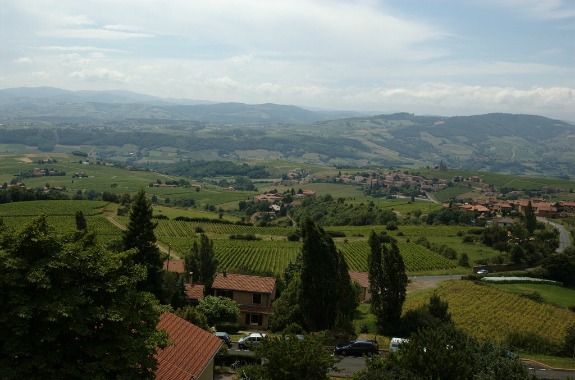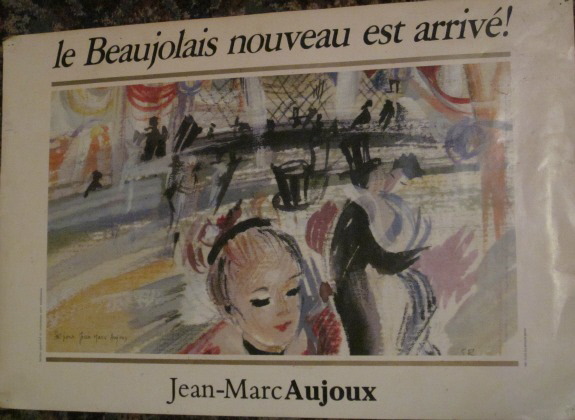The History of Beaujolais Nouveau Day
There’s no better time to try this fruity red wine than today, the third Thursday in November, when the French celebrate the release of the new vintage
Beaujolais Nouveau Day arrives every third Thursday in November—as do about 65 million bottles of red wine just two months old. Throughout France, posters like this one are hung in bars, restaurants and cafés, helping to generate the phenomenal hype that surrounds the wine. Photo by Alastair Bland.
The unlikely rise to fame of a tepid and unimposing wine could be one of the most heartening stories in the world of noble French vines, stodgy oenophiles and glittering stemware. For Beaujolais Nouveau, the fruity pinkish-red wine of eastern France’s Beaujolais region, has gone from cheap plonk to superstar (though still cheap) and, every third Thursday in November, drives millions of French into revelry the very second the new vintage is released.
In fact, the French have been partying with their glasses full of Beaujolais Nouveau since exactly 12:01 a.m. local time, the moment at which it becomes legal each year to release the wine. As the name implies, Beaujolais Nouveau is “new”—young, that is—and goes to the bottle not even two months after the crush. Lacking some in maturity and finesse, the wine was traditionally just a guzzler for the table and something with which to celebrate the end of the exhausting harvest season, but over time the wine’s release became an anticipated event, and the wine itself—though still not considered a stunner—the cause for celebration. In the 1950s, distributors began competing each year in a race to deliver the first bottles to Paris. In the 1970s, winemaker and businessman Georges Duboeuf, a major producer of Beaujolais Nouveau, pushed and publicized the wine and the associated festivities. Banners proclaiming “Le Beaujolais Nouveau est arrivé!” became commonplace, and the race from Beaujolais to Paris attracted increasing media coverage each year. People around the world soon would acquire a taste for the wine and anticipate the day of arrival each fall, and spotlight-seeking wine merchants have made deliveries by elephant and rickshaw and motorcycle. Today, Beaujolais Nouveau is a star and the day of its release one of the biggest parties of the year.
So how did such a tale of success and triumph happen to carry a moderately good red wine, at best—and a close neighbor to the fine wines of Burgundy—into the heights of world fame? First of all, people like to drink—and surely the opportunity to suck down a wine that carries symbolic value of the finished season while also demanding no tiresome critical analysis was refreshing for the French. But Beaujolais Nouveau Day is also a product of heavy and unabashed marketing. For 34 years starting in 1951, November 15 was the official release date, but it seems to have been a calculated decision in 1985 when the Beaujolais regional government decided that the big day, always, would be a Thursday—a day when party-prone people are more likely to jumpstart their weekend. And though it may be just coincidence, Beaujolais Nouveau’s arrival just a week prior to Thanksgiving has given American marketers something to bang over the heads of their consumers—specifically, that Beaujolais Nouveau is a superb match for turkey. Perhaps—but it’s just as probable that, with millions of bottles of the wine abruptly available right as 45 million American turkeys meet their maker, producers saw a perfect and timely marketing marriage.

Vines and villages bring a classic French beauty to the wine region of Beaujolais. The wine itself is considered quite mediocre. Photo courtesy of Flickr user L y J.
Now, with third-Thursday parties underway (120 public celebrations take place each year in Beaujolais alone), turkeys filling out in their last days, and millions of Nouveau bottles exchanging hands throughout the world, the time to taste the first wine of 2012 has arrived. Beaujolais Nouveau is generally cheap—10 bucks and less—and is available from scores of companies, including Domaine Dupeuble, Jean Foillard and, most famous of all, Georges Duboeuf, which sends almost two million bottles to America bearing the colorful confetti-esque label familiar to many wine drinkers and as cheerful as the third Thursday itself.
But cheery bottle labels and the festivities of Beaujolais Nouveau Day may belie recent drops in sales of the wine and the lagging spirits in the Beaujolais region. By many reports, people have lost some interest in the wine’s release. Some shops are seeing a longer turnover in inventory, and many restaurants are throwing scaled-down Beaujolais bashes. In the United Kingdom, Beaujolais Nouveau consumption peaked in 1999 at about 740,000 bottles. That figure has since slid dramatically, to just 100,000 bottles in 2011. This season, after some rough weather and a damaged crop, low sales are just as likely. In the producing region, in fact, declining returns seem to be attracting few young winemakers to invest in a future here. The winemakers of the region are collectively aging—and, after all the years of fanfare and comedic races to bring the wine to market, Beaujolais Nouveau itself may be growing old.
Many people have never cared for it, anyway, and although more than half of Beaujolais Nouveau is consumed in France, the wine has a relatively cool reputation in its home country. Wine snobs may snicker at Beaujolais Nouveau, and many otherwise enthused wine drinkers see little to be gained from consuming it. The wine, indeed, is very low in tannins, which makes it largely unsuitable for long-term aging, while also leaving it top-heavy with fruit flavors, delicious to some palates, cloying to others. The wine, as a general rule, is simple—but its this very simplicity, and the rapidity of production, that is so attractive. The wine is fresh, youthful, vibrant, cheerful—and except for several weeks of fermentation and handling, Beaujolais Nouveau is as close as you can get to drinking wine straight from a vine.
A few Beaujolais Nouveau factoids to spice up the conversation at Thanksgiving dinner:
The region of Beaujolais is a swath of fertile hills 34 miles north to south and between seven and nine miles wide. The area’s 2,300 farmers produce several grape varieties, but only one—the Gamay grape—is permitted in Beaujolais Nouveau.
Japan is the world’s largest importer of Beaujolais Nouveau. Germany is second. The United States is third.
Using the word “Beaujolais” is illegal for winemakers in America, but “nouveau” is up for grabs, and many American winemakers produce their own renditions of nouveau wines. Many use the Gamay grape and strive to replicate the new wines of Beaujolais, even releasing the wine on Beaujolais Nouveau Day to absorb some of the excitement. Others use different grapes. New Clairvaux, a winery in the northern end of the Sacramento Valley, makes a Nouveau Tempranillo, while River Road Family Vineyards and Winery, about 60 miles north of San Francisco, makes a Pinot Noir Nouveau.
“New” wines are also made in the Czech Republic, Italy and Spain.
A poor harvest in 2012 could force hundreds of Beaujolais grape growers into bankruptcy.
Banana scents, commonly cited as a fault of Beaujolais Nouveaus, are the aromatic results of isoamyl acetate, a fermentation byproduct.
Planning Your Next Trip?
Explore great travel deals
Smithsonian magazine participates in affiliate link advertising programs. If you purchase an item through these links, we receive a commission.
/https://tf-cmsv2-smithsonianmag-media.s3.amazonaws.com/accounts/headshot/Off-Road-alastair-bland-240.jpg)

/https://tf-cmsv2-smithsonianmag-media.s3.amazonaws.com/accounts/headshot/Off-Road-alastair-bland-240.jpg)